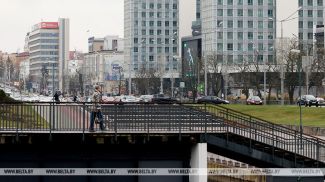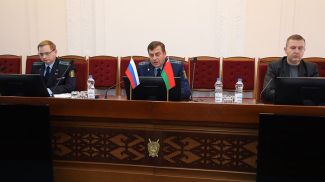KAMENETS DISTRICT, 2 February (BelTA) – Scientists and the State Control Committee of Belarus have established that the construction of fencing on Poland's border with Belarus will cause irreparable damage to Belovezhskaya Pushcha, BelTA has learned.
Thanks to Belarus, vast swathes of Europe's last primeval forest have been preserved in their natural state. Belovezhskaya Pushcha is included in the UNESCO World Heritage List as a transboundary property. Its division into parts and creation of artificial barriers threaten the existence of rare ecosystems. For example, Belovezhskaya Pushcha is home to the largest population of the forest's iconic species, the European bison, as well as more than 1,000 species of higher plants, many of which are relict, more than 12,000 species of invertebrates and 362 species of vertebrates. Scientists are concerned about the construction of border fencing with related infrastructure and engineering networks on the territory of Belovezhskaya Pushcha. By the way, no studies, including environmental ones, will be carried out, though comprehensive research is the only way to assess the potential damage to ecosystems and identify ways to minimize the negative impact.
The problem, of course, is in the construction of the fence and the division of this single transboundary property, its flora and fauna into parts. This applies to ungulates, predators. For example, the fence will split a bison population in half. Some 1,500 head live in Belovezhskaya Pushcha: roughly half of them in Belarus and the other half in Poland. The bison population was restored from several individuals. Its genetic diversity is extremely low. Dividing the forest with the fence will impoverish the gene pool,” said Pavel Geshtovt, a researcher at the Scientific and Practical Center for Bioresources of the National Academy of Sciences of Belarus. The fence can hamper reproduction, resettlement and access to food of wolves, lynxes and bears.
The State Control Committee established that the erection of a temporary border fence in August-September 2021 had already had a negative impact on wildlife. Bison, deer, elk, and roe deer gather in the border strip between engineering structures. Some of them die. By the way, this place became a trap for a group of bison. The herd came here from the territory of Poland. Due to artificial barriers, ungulates cannot return back. Trapped in this area during the wintertime they are on the brink of starvation. Employees of the Belovezhskaya Pushcha national park feed the animals, looking for ways to save them. Unfortunately, one out of 20 bison died trying to get through the barbed wire into Poland.
Changes in the life of Belovezhskaya Pushcha can lead to a reduction or disappearance of not only rare but also common species of flora and fauna. "The consequences of the forest fragmentation are difficult to predict. Figuratively speaking, it can be compared to the Berlin Wall for nature. The work is carried out at an accelerated pace. The construction can create flooding risks in the future," said Dmitry Grummo, Deputy Director for Research at the Institute of Experimental Botany of the National Academy of Sciences of Belarus. “Disruption of the hydrological regime threatens the valuable old-aged deciduous and black alder forests, carries risks of shallowing of the rivers, the loss of some swamps that are the habitat of very rare birds.
"Belovezhskaya Pushcha is a single large forest in the center of Europe. It has been undisturbed for many centuries. What we have here is something unique, unmatched for the European plain. We must preserve Belovezhskaya Pushcha. It has always been managed as a single whole. Until 1944, there were no state borders there. The border was largely administrative," said Dmitry Bernatsky, head of the scientific department of the Belovezhskaya Pushcha National Park.
The Belovezhskaya Pushcha National Park has several large scientific centers. Polish scientists and their colleagues from other countries, and also local residents are calling on the authorities to suspend the construction of the fence in the forest.
The Belarusian State Control Committee began an inspection of the national park. Experts intend to assess the possible damage that the fence will cause. "According to estimates, it will amount to at least $100 million. This engineering structure will be installed by means of cutting down a strip in the forest, which will destroy the soil cover and will cause soil degradation,” noted Vasily Rudenik, Deputy Head of the Main Directorate - Head of the Department of the State Control Committee. “From open sources we know that this will be a metal structure 5 meters high with barbed wire at the top. Imagine what kind of foundation is needed to hold it. This will be a huge structure.”













